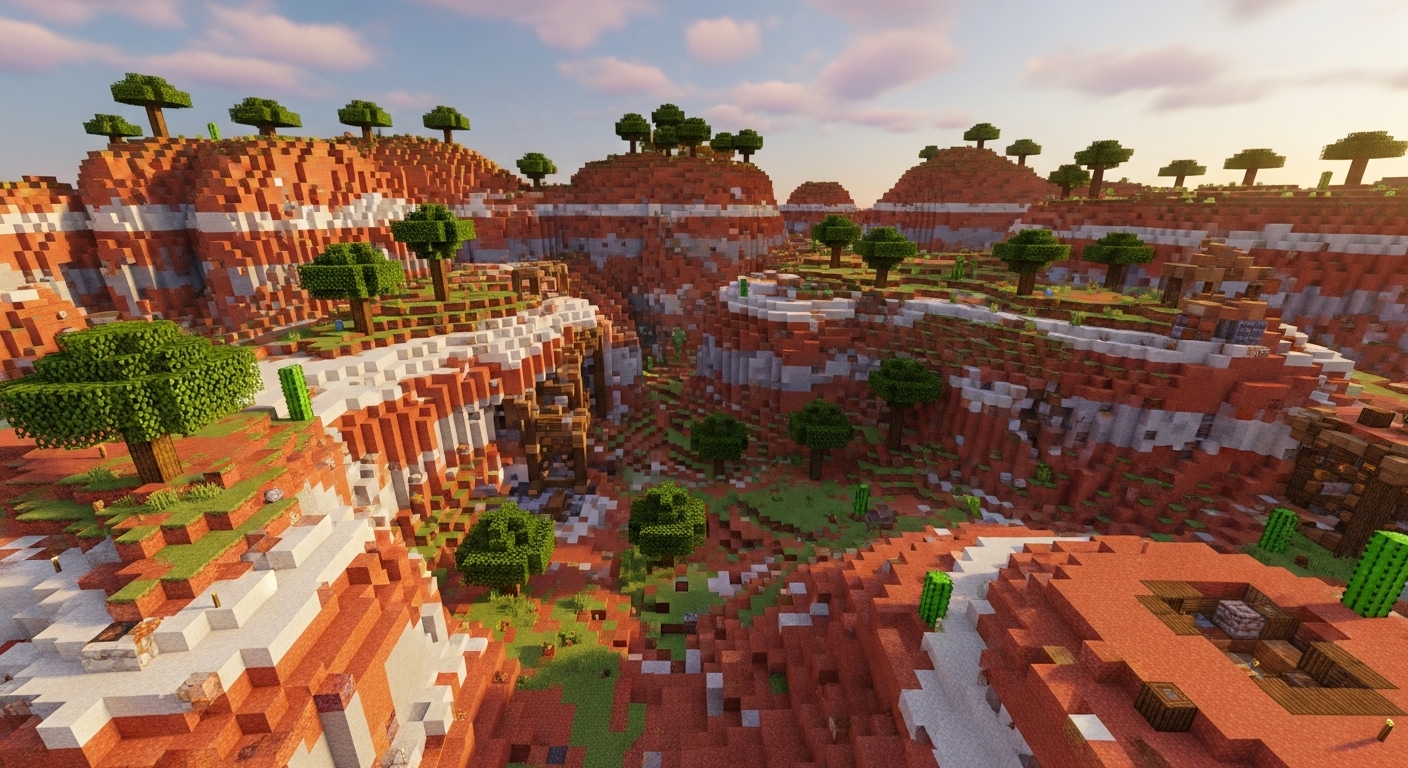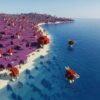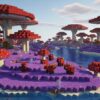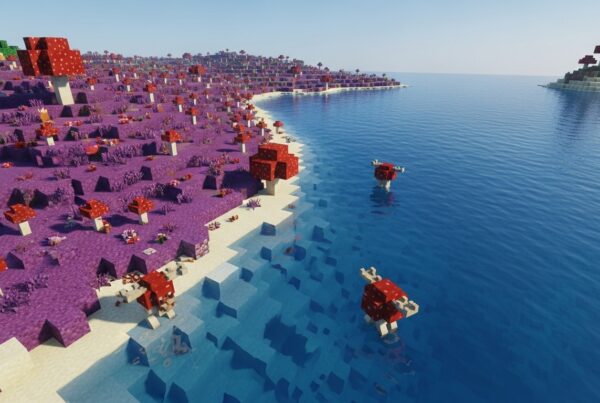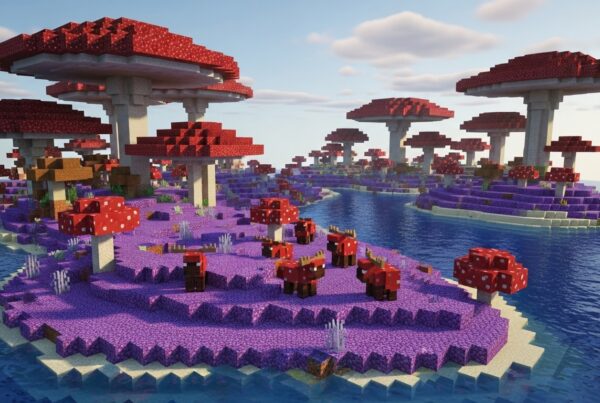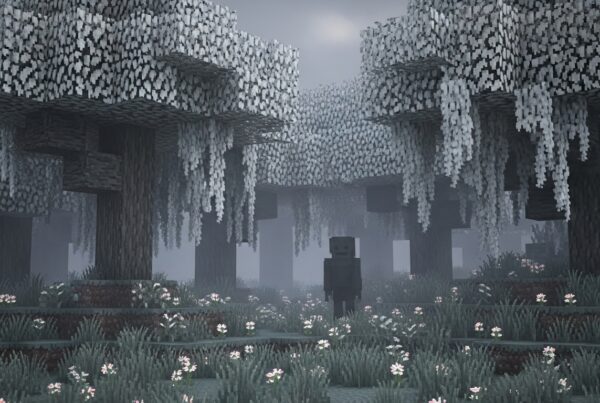The Wooded Badlands biome is one of Minecraft’s most dramatic and resource-rich warm biomes, blending the harsh desert-like terrain of the Badlands with rare patches of vegetation and towering terracotta formations. Known for its massive gold ore veins, abundant surface mineshafts, and striking red sand landscapes, this biome is both visually stunning and uniquely challenging to survive in.
This fully enhanced guide covers everything you need to know—generation, resources, terrain, survival strategies, seeds, and expert building tips—to help you thrive in your next Wooded Badlands world.
What Is the Wooded Badlands Biome?
The Wooded Badlands biome is a warm, arid biome that features the colorful canyon terrain of the Badlands but with sparse oak trees, grass patches, and slightly more forgiving plateaus. Although still harsh, the limited vegetation makes it easier to survive here than in the standard Badlands.
Key Characteristics
- Red sand covering most surfaces
- Massive terracotta and hardened clay cliffs
- Sparse oak trees for early-game wood
- No rainfall; dry, dusty atmosphere
- High plateaus and steep canyons
- Warm climate with unique yellow-brown foliage tint
How It Differs From Other Badlands Variants
- Wooded vegetation: Includes oak trees and small patches of dirt and coarse dirt.
- More survival-friendly: Wood available locally, unlike typical Badlands.
- Less extreme erosion: Smoother terrain compared to Eroded Badlands.
- Better early shelter: Grass and dirt patches allow minimal early farming.
- Higher plateaus: Terrain tends to generate larger flat areas.
Climate, Terrain, and Generation
Climate Details
- Warm/dry biome
- Never rains (weather always clear)
- Grass and leaves appear yellow-brown, even when transported from other biomes
- Temperature has no mechanical effect but contributes to the biome’s distinct look
Terrain Features
- Towering terracotta cliffs with multi-layered colors
- Red sand, cacti, and dead bushes scattered throughout
- Plateaus ideal for base-building
- Deep canyons and exposed ravines
- Limited natural water sources
After the 1.18 terrain update, Wooded Badlands plateaus are taller and more dramatic, often rising above Y=200.
Wooded Badlands Plateau Variant
While Minecraft consolidated biome names in 1.18+, many players still refer to:
- Wooded Badlands Plateau
- Badlands Plateau
These variants feature:
- Larger, flatter mesas
- More buildable terrain
- High-elevation woodland patches
Common Neighboring Biomes
You’ll often find Wooded Badlands beside:
- Badlands
- Eroded Badlands
- Desert
- Savanna
- Warm Oceans
These biome transitions create scenic, warm-region maps with great variety.
Blocks, Resources, and Plants
Common Blocks
- Red Sand
- Terracotta (all natural colors)
- Dirt, Coarse Dirt
- Oak Logs and Leaves
- Dead Bushes
- Stone, Andesite, Granite
- Sandstone and Red Sandstone
Vegetation
- Sparse Oak Trees
- Dead bushes (renewable sticks)
- Cacti
- Occasional patches of grass/shrubs
Resource Breakdown Table
| Resource Type | Examples | Notes |
|---|---|---|
| Primary Blocks | Terracotta, Red Sand | Unlimited and ideal for building |
| Vegetation | Oak Trees, Dead Bushes | Sparse but essential for survival |
| Underground Ores | Gold, Iron, Coal | Gold generation is significantly higher here |
| Loot Sources | Mineshaft Chests | Bread, seeds, rails, enchanted books |
Gold Ore Generation
One of the most important features of all Badlands variants is their unique ore distribution.
- Gold ore generates at any elevation, including well above sea level.
- Large gold veins frequently appear in cliff faces.
- Wooded Badlands is one of the best gold-farming biomes in the game.
Mobs That Spawn in the Wooded Badlands
Passive and Neutral Mobs
- Rabbits (desert variant)
- Bats underground
- Occasional traveling merchants wandering from adjacent biomes
Hostile Mobs
- Zombies
- Skeletons
- Spiders
- Creepers
- Cave mobs underground
- Husks spawn in neighboring desert regions and may wander into the badlands
Mob Density Notes
- Low passive mob count makes food scarce
- Hostile mobs can gather in valleys and shaded mineshafts
- Rabbits are often the only natural food source, and they spawn infrequently
Structures and Terrain Features
Generated Structures
- Mineshafts (high density):
- Wooded Badlands have the highest surface mineshaft spawn rate in the game.
- Many mineshafts generate at Y>70 due to elevated terrain.
- Wooden supports often appear exposed on mesa walls.
- Minecart chests provide food, seeds, and loot.
- Ruined Portals
- Nearby Villages (Desert or Savanna):
- Villages do not generate inside the biome
- However, desert villages often spawn right beside Wooded Badlands
- Villagers can wander onto red sand
- Note: Villages bordering Wooded Badlands do not generate crops on badlands soil
Natural Terrain Highlights
- Massive layered cliffs with dramatic color bands
- Wide plateaus perfect for megabases
- Exposed ores on canyon walls
- Scenic vistas ideal for creative builds
Best Uses for the Wooded Badlands Biome
Building Opportunities
The biome’s natural color palette offers unmatched aesthetic potential.
Great build themes include:
- Western towns / frontier settlements
- Mining towns inspired by the American Southwest
- Cliffside mansions
- Terracotta megabases
- Rail systems carved into mesa walls
- Canyon bridges or skyways
Local Building Materials
- Terracotta (all colors)
- Red sandstone and smooth red sandstone
- Coarse dirt
- Rails and wood from mineshafts
- Gold blocks (crafted from abundant gold ore)
Resource Advantages
- Gold-rich terrain
- Tons of terracotta for large decorative builds
- Red sand for TNT and colored sandstone
- Mineshafts rich in loot and rails
- Ideal for exploration and adventure maps
Survival Tips for Wooded Badlands
Key Challenges
- Extremely limited food sources
- Scarce water
- Minimal vegetation
- Dangerous cliffs and fall risks
- Few early mobs to farm for resources
Food Strategies
To survive your first few days:
- Loot mineshaft chests for bread, melon seeds, beetroot seeds
- Steal crops from nearby desert or savanna villages
- Fish in rivers, oceans, or village wells
- Hunt rabbits (unreliable, but early help)
- Bring seeds and livestock from neighboring biomes
Water Scarcity Tips
- Natural water is extremely rare
- You must bring water buckets to set up farms
- Create infinite water sources manually
- Be cautious with farmland drying out quickly
Fire Spread Risks
Wooded Badlands have dry vegetation:
- Oak trees and dead bushes ignite easily
- Fire spreads rapidly in mesa terrain
- Use caution with lava or flint and steel near builds
Navigation Tips
The terrain can be perilous:
- Carry ladders for cliff-scaling
- Use water buckets to descend safely
- Mark paths with torches on cliff walls
- Avoid sprinting near canyon edges
- When mining, note that caves may open unexpectedly into deep drops
Late-Game Strategies
- Build farms, water systems, and tree farms
- Create cliffside pathways or anchored bridges
- Use terracotta as primary building material
- Set up a gold farm alternative using naturally spawned gold ore
- Use elytra for fast mesa navigation
Java & Bedrock Differences
While the biome exists on both editions, generation details vary:
Java Edition
- More dramatic cliff shapes
- Mineshafts spawn at higher elevations
- Terrain height variance is larger
- Larger exposed gold veins
Bedrock Edition
- Slightly smoother mesa formations
- Mineshaft layouts differ
- Gold ore distribution similar but sometimes less exposed on surface cliffs
Recommended Minecraft Seeds (Java & Bedrock)
Java Edition Seeds
Seed: 744512919
Feature: Massive Wooded Badlands plateau with several surface mineshafts
Spawn: Near canyon entrance
Notes: Excellent for loot-focused survival starts.
Seed: 2098541123
Feature: Wooded Badlands beside Desert and Savanna villages
Notes: Perfect for early trading, renewable crops, and structured survival routes.
Seed: -881329770
Feature: Wooded Badlands next to Warm Ocean
Notes: Access to coral reefs, shipwrecks, and warm-water fishing.
Seed: 13377820
Feature: Dramatic cliffs rising above Y=200
Notes: Ideal for sky bases and cinematic builds.
Seed: 964188
Feature: Multiple exposed mineshafts and gold-rich canyon walls
Notes: Great for players hunting early treasure.
Bedrock Edition Seeds
Seed: 178224315
Feature: Expansive Wooded Badlands with towering plateaus
Notes: Perfect scenic seed for large builds.
Seed: 99182144
Feature: Badlands bordering a Desert village and Ruined Portal
Notes: Easy access to villagers and early loot.
Seed: 60284173
Feature: Wooded Badlands with several exposed mineshaft entrances
Notes: Exploration-rich start with plentiful resources.
Seed: 343548616
Feature: High cliffs and deep canyons with visible gold ore
Notes: Excellent for mining and adventure gameplay.
Seed: 77000400
Feature: Wooded Badlands next to Savanna Plateau
Notes: Rare biome combination with amazing screenshot potential.
Frequently Asked Questions
Is the Wooded Badlands biome rare?
Yes. Badlands are rare overall, and Wooded Badlands is a less common variant.
Do villages spawn in this biome?
No. However, villages near deserts and savannas often spawn adjacent to the Wooded Badlands.
Why is gold so common here?
Badlands biomes have special ore rules that dramatically increase gold generation at all elevations.
What’s the biggest challenge when surviving here?
Food and water scarcity, plus steep drop-offs that can cause fall damage.
Do mineshafts really spawn on the surface?
Yes—Wooded Badlands generate the highest number of surface mineshafts in Minecraft.
Conclusion
The Wooded Badlands biome is a stunning, gold-rich, and challenge-heavy biome that rewards explorers, builders, and survivalists alike. Its unique terrain, abundant terracotta, and rare vegetation make it ideal for scenic bases and themed worlds, while its abundant gold and exposed mineshafts provide exciting gameplay opportunities.
Whether you’re planning a frontier-style settlement, a cliffside megabase, or a loot-centric survival run, the Wooded Badlands is one of the most rewarding biomes to explore in Minecraft.
